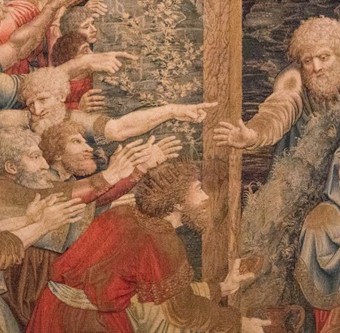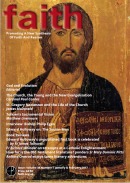
St. Gregory Nazianzen and the Life of the Church
James J McDonald
Has a “golden age” for the Church ever existed? Certainly not in the 4th century. The life of St Gregory Nazianzen bears witness to that. Gregory was born in 329 AD to his mother, Nonna, and father, Gregory senior, on the family estate in the village of Arianzus in the province of Cappadocia, south of modern-day Ancyra. His mother was a committed Christian from a Christian family.
Under Nonna’s influence, his father converted to Christianity from Hypsistarianism – a small cult that involved a strange mix of Hellenic and Judaeo-Christian ideas. Gregory senior became bishop of the neighbouring town of Nazianzus and lived to see 100. The practice of celibate bishops (with the allowance of married priests) was
not stringently in place at the time – although it would become the norm in the east as we see today. (See J. McGuckin’s thorough biography of Gregory Nazianzen (St. Vladimir’s Seminary Press, 2001); and also R. Ruether’s biography (Clarendon Press, 1969)).
This blessing was perhaps in some ways a curse for the younger Gregory, for his father would become an over-bearing influence throughout his son’s life. After receiving an extensive education in Caesarea in Cappadocia, Caesarea-Palestine, Alexandria and Athens (where he began his turbulent friendship with Basil of Caesarea), Gregory went home and was forcibly ordained by his father. He fled soon after to join Basil in a monastic community set up by the future bishop. He eventually came back to his pastoral duties, but he was never really comfortable in the role, always longing for the life of prayer and study that the monastic life offered.
Constantinople
Fast forward to the year 379/80 and we find Gregory ministering to the insignificantly small Nicene community in the city of Constantinople. The Nicene, a supporter of Nicaea, was a rare and eccentric creature in mainstream society at that time. After years of imperial support for the homoian (Arian) position – the belief that the Son is like the Father in substance, but not consubstantial – very few people actually held to the Council of Nicaea’s decree with much seriousness.
The small Church of the Anastasia (resurrection) was his base of operations – and indeed it seemed that he would need nothing short of a miracle on the level of the resurrection in order to win the city over to the Nicene cause. If the Church of the 21st century seems divided to some, then it is nothing compared to the Church in the east during Gregory’s ministry. Homoousians (supporters of the Council of Nicaea), homoiousians, Eunomians pneumatomachians and many other groups that gathered around theological positions or prominent personalities all jostled for pole position in what was a politically turbulent time.
The struggle to gain episcopal power could be bloody. A prominent political figure in the east, Modestus, is said to have put 80 priests who were opposed to the Emperor Valens’ theological reforms out to sea and set the ship on fire. Gregory’s friendship with Basil was also put under severe strain when Basil forcibly made him Bishop of Sasima in 372 – a veritable backwater in the province of Cappadocia – in order to consolidate his power in the region. The appeal of Arianism was perhaps found in its ambiguity.
The aim of the various emperors at that time was less concerned with getting to the truth of Christian doctrine, but rather finding a creed that was ambiguous enough so that everyone – or most people - could agree to it, thus bringing peace and relative religious unity throughout the empire.
Arian monks
But the peoples living in the eastern Mediterranean of the time were much too passionate to compromise. The testosterone-fuelled clashes that we see on the news periodically between various factions of monks that tend to the shrines of the Holy Land was a much more common and widespread occurrence in the 4th century. Gregory’s first paschal celebration at the church of the Anastasia was interrupted by an invasion of Arian monks, nuns and local rabble rousers who unceremoniously pelted his congregation with stones. Luckily the only thing worse than their theology – according to Gregory – was their aim, and so he escaped relatively unscathed.
Yet the message was clear: the Cappadocian rhetorician was most certainly not welcome. Not all was lost, however. The emperor of the east, Theodosius, was a prominent supporter of the Nicene cause (perhaps if only to seem like the true heir to Constantine the Great), and in 380 he arrived at Constantinople after a victorious campaign against the Goths. Gregory was promptly (and under armed guard) installed as Archbishop of the city and the Arian clergy were exiled.
Council
The Council of Constantinople was convened in 381 and Gregory chaired the proceedings. One of Gregory’s main concerns was to have a formal declaration of the divinity of the Holy Spirit. This was something that (most) supporters of Nicaea seemed to believe, even if they were wholly reticent about it. Even Basil would not use the word ‘consubstantial’ to describe the Holy Spirit, and only went as far as to say that the Spirit was honoured along with the Father and Son. This reticence was shared by most of the Council Fathers, and many more were openly hostile to such a declaration. This insistence, along with Gregory’s general ineptitude in ecclesiastical matters, led to his eventual ejection from the Council and from the episcopal throne of Constantinople.
The consequences of this can be seen in the creed that we profess every Sunday during Mass: ‘I believe in the Holy Spirit … with the Father and Son He is adored and glorified’. Nowhere does it say in the text explicitly that He is consubstantial with the Father and Son.
Mainstream
So why do we have today in mainstream, orthodox Christendom such a strong belief in the divine status of the Holy Spirit? Gregory might have had a chequered career in the Church, but the beauty of his writings – spanning from letters, speeches and beautiful poetry – were recognised by subsequent ages and became so popular in the east that Gregory is the only saint to have the title ‘theologian’ apart from Simon the new theologian, and the Apostle John. The beauty of Gregory’s theology can be found in its simplicity: The philosophical wrangling of the Arians or Pagans is pointless. God is ineffable. God is mysterious. And so the only way to ascend to Him, to converse with Him, and live a life pleasing to Him is through prayer and purification. We must, like Moses, Elijah or the apostles on Tabor, ascend the mountain in fear and trembling.
We must love our neighbour, and care for the sick. In one oration given to help Basil raise money for a hospice he was building for lepers outside Caesarea, Gregory writes: “We must open our hearts then to all the poor, to those suffering evil for any reason at all, according to the Scripture that commands us to “rejoice with those who rejoice and weep with those who weep.” (Oration 14.6, as translated by B.E. Daley, S.J. (Routledge, 2006:78).
In other words, it is not thanks to magisterial Church documents that we have this central tenet of the Faith (although I am sure by now that it is certainly secured by decree of the Magisterium), but thanks to the faithful and saintly life and writings of one man from a far flung province of the Roman empire who would rather retreat to the quiet of the cloister than rule from the episcopal throne (though he clearly felt quite bitter about losing the latter). This is worth bearing in mind for the Catholics of today.
Notes:
James J. McDonald is a PhD candidate in Classics at the University of Glasgow.





